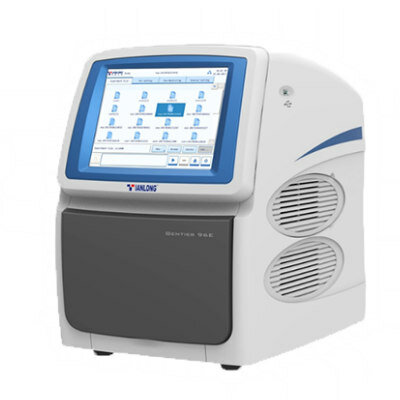Pan-Cancer Analysis of Tumor Mutations Points to Predictive Biomarkers
|
By LabMedica International staff writers Posted on 05 Jul 2022 |

Quantifying the effectiveness of different cancer therapies in patients with specific tumor mutations is critical for improving patient outcomes and advancing precision medicine. A key goal of precision medicine is to characterize how patients with specific genetic mutations respond to therapies.
Advances in modeling mutation–treatment interactions can potentially improve patient outcomes by recommending promising treatments based on each patient’s distinct tumor mutation profile. These interactions are especially important for guiding therapies for cancer, which is driven by heterogeneous mutations.
Biomedical Scientists at Stanford University (Stanford, CA, USA) and their colleagues used a gene-level analytical strategy, and searched for ties between tumor mutation profiles, cancer treatment histories, and survival patterns. Their dataset included electronic health record (EHR) entries and targeted Foundation Medicine panel sequence profiles for hundreds of cancer-related genes in more than 40,900 de-identified cancer patients who are part of the Flatiron Health-Foundation Medicine (New York, NY, USA) clinicogenomic database.
The participants included more than 12,900 individuals with advanced non-small cell lung cancer (NSCLC), nearly 7,900 metastatic breast cancer patients, almost 3,900 individuals with ovarian cancer, some 3,500 patients with metastatic pancreatic cancer, and thousands more patients with advanced bladder cancer, renal cell carcinoma, or melanoma. The team explained, noting that the results were verified using data for nearly 3,900 additional advanced lung, breast, or colorectal cancer cases from an American Association for Cancer Research (Philadelphia, PA, USA) dataset.
The team flagged 458 apparent mutation markers for survival in cancer patients receiving specific treatment protocols and uncovered specific mutations that typically co-occur with other tumor alterations. The investigators found that mutations in 42 genes tracked with survival outcomes in at least one of the cancer types considered, for example. These genes, in turn, showed almost 100 significant interactions.
Consistent with past studies that showed ties between EGFR inhibitor resistance and KRAS mutations in advanced NSCLCs, they saw shorter-than-usual survival for KRAS-mutated cases treated with EGFR inhibitors and enhanced survival in EGFR inhibitor-treated advanced NSCLC patients with KRAS-wild type tumors. When the team looked at mutation-mutation interactions across genes such as ALK, BRAF, EGFR, MET, RET, ROS1, ERBB2, or PIK3CA that are currently targeted by FDA-approved treatments, it found genes that were more or less likely to be mutated in conjunction with alterations affecting the targeted genes.
The authors concluded that their findings demonstrate that high-quality, real-world clinicogenomic data from patients with cancer can be an important resource for investigating such mutation-treatment interactions by capturing outcome information of patients on diverse treatments. As tumor sequencing data become increasingly linked to the EHR, such data combined with careful computational analysis can greatly benefit precision medicine. The study was published on June 30, 2022 in the journal Nature Medicine.
Related Links:
Stanford University
Flatiron Health-Foundation Medicine
American Association for Cancer Research
Latest Pathology News
- Spatial Tissue Analysis Identifies Patterns Associated With Ovarian Cancer Relapse
- Unique Hand-Warming Technology Supports High-Quality Fingertip Blood Sample Collection
- Image-Based AI Shows Promise for Parasite Detection in Digitized Stool Samples
- Deep Learning Powered AI Algorithms Improve Skin Cancer Diagnostic Accuracy
- Microfluidic Device for Cancer Detection Precisely Separates Tumor Entities
- Virtual Skin Biopsy Determines Presence of Cancerous Cells
- AI Detects Viable Tumor Cells for Accurate Bone Cancer Prognoses Post Chemotherapy
- First Ever Technique Identifies Single Cancer Cells in Blood for Targeted Treatments
- Innovative Blood Collection Device Overcomes Common Obstacles Related to Phlebotomy
- Intra-Operative POC Device Distinguishes Between Benign and Malignant Ovarian Cysts within 15 Minutes
- Simple Skin Biopsy Test Detects Parkinson’s and Related Neurodegenerative Diseases
- Bioinformatics Tool to Identify Chromosomal Alterations in Tumor Cells Can Improve Cancer Diagnosis
- Coin-Sized Device Rapidly Isolates Blood Plasma for Quicker and More Precise Clinical Diagnoses
- AI Predicts Cancer Spreading To Brain from Lung Biopsy Images
- Improved Microneedle Technology Speeds Up Extraction of Sample Interstitial Fluid for Disease Diagnosis
- AI Outperforms Expert Pathologists in Predicting Lung Cancer Spread
Channels
Clinical Chemistry
view channel
3D Printed Point-Of-Care Mass Spectrometer Outperforms State-Of-The-Art Models
Mass spectrometry is a precise technique for identifying the chemical components of a sample and has significant potential for monitoring chronic illness health states, such as measuring hormone levels... Read more.jpg)
POC Biomedical Test Spins Water Droplet Using Sound Waves for Cancer Detection
Exosomes, tiny cellular bioparticles carrying a specific set of proteins, lipids, and genetic materials, play a crucial role in cell communication and hold promise for non-invasive diagnostics.... Read more
Highly Reliable Cell-Based Assay Enables Accurate Diagnosis of Endocrine Diseases
The conventional methods for measuring free cortisol, the body's stress hormone, from blood or saliva are quite demanding and require sample processing. The most common method, therefore, involves collecting... Read moreMolecular Diagnostics
view channel
Unique Autoantibody Signature to Help Diagnose Multiple Sclerosis Years before Symptom Onset
Autoimmune diseases such as multiple sclerosis (MS) are thought to occur partly due to unusual immune responses to common infections. Early MS symptoms, including dizziness, spasms, and fatigue, often... Read more
Blood Test Could Detect HPV-Associated Cancers 10 Years before Clinical Diagnosis
Human papilloma virus (HPV) is known to cause various cancers, including those of the genitals, anus, mouth, throat, and cervix. HPV-associated oropharyngeal cancer (HPV+OPSCC) is the most common HPV-associated... Read moreHematology
view channel
Next Generation Instrument Screens for Hemoglobin Disorders in Newborns
Hemoglobinopathies, the most widespread inherited conditions globally, affect about 7% of the population as carriers, with 2.7% of newborns being born with these conditions. The spectrum of clinical manifestations... Read more
First 4-in-1 Nucleic Acid Test for Arbovirus Screening to Reduce Risk of Transfusion-Transmitted Infections
Arboviruses represent an emerging global health threat, exacerbated by climate change and increased international travel that is facilitating their spread across new regions. Chikungunya, dengue, West... Read more
POC Finger-Prick Blood Test Determines Risk of Neutropenic Sepsis in Patients Undergoing Chemotherapy
Neutropenia, a decrease in neutrophils (a type of white blood cell crucial for fighting infections), is a frequent side effect of certain cancer treatments. This condition elevates the risk of infections,... Read more
First Affordable and Rapid Test for Beta Thalassemia Demonstrates 99% Diagnostic Accuracy
Hemoglobin disorders rank as some of the most prevalent monogenic diseases globally. Among various hemoglobin disorders, beta thalassemia, a hereditary blood disorder, affects about 1.5% of the world's... Read moreImmunology
view channel
Diagnostic Blood Test for Cellular Rejection after Organ Transplant Could Replace Surgical Biopsies
Transplanted organs constantly face the risk of being rejected by the recipient's immune system which differentiates self from non-self using T cells and B cells. T cells are commonly associated with acute... Read more
AI Tool Precisely Matches Cancer Drugs to Patients Using Information from Each Tumor Cell
Current strategies for matching cancer patients with specific treatments often depend on bulk sequencing of tumor DNA and RNA, which provides an average profile from all cells within a tumor sample.... Read more
Genetic Testing Combined With Personalized Drug Screening On Tumor Samples to Revolutionize Cancer Treatment
Cancer treatment typically adheres to a standard of care—established, statistically validated regimens that are effective for the majority of patients. However, the disease’s inherent variability means... Read moreMicrobiology
view channel
Mouth Bacteria Test Could Predict Colon Cancer Progression
Colon cancer, a relatively common but challenging disease to diagnose, requires confirmation through a colonoscopy or surgery. Recently, there has been a worrying increase in colon cancer rates among younger... Read more.jpg)
Unique Metabolic Signature Could Enable Sepsis Diagnosis within One Hour of Blood Collection
Sepsis is a life-threatening condition triggered by an extreme response of the body to an infection. It requires immediate medical intervention to prevent potential death or lasting damage.... Read moreTechnology
view channel
New Diagnostic System Achieves PCR Testing Accuracy
While PCR tests are the gold standard of accuracy for virology testing, they come with limitations such as complexity, the need for skilled lab operators, and longer result times. They also require complex... Read more
DNA Biosensor Enables Early Diagnosis of Cervical Cancer
Molybdenum disulfide (MoS2), recognized for its potential to form two-dimensional nanosheets like graphene, is a material that's increasingly catching the eye of the scientific community.... Read more
Self-Heating Microfluidic Devices Can Detect Diseases in Tiny Blood or Fluid Samples
Microfluidics, which are miniature devices that control the flow of liquids and facilitate chemical reactions, play a key role in disease detection from small samples of blood or other fluids.... Read more
Breakthrough in Diagnostic Technology Could Make On-The-Spot Testing Widely Accessible
Home testing gained significant importance during the COVID-19 pandemic, yet the availability of rapid tests is limited, and most of them can only drive one liquid across the strip, leading to continued... Read moreIndustry
view channel
ECCMID Congress Name Changes to ESCMID Global
Over the last few years, the European Society of Clinical Microbiology and Infectious Diseases (ESCMID, Basel, Switzerland) has evolved remarkably. The society is now stronger and broader than ever before... Read more
Bosch and Randox Partner to Make Strategic Investment in Vivalytic Analysis Platform
Given the presence of so many diseases, determining whether a patient is presenting the symptoms of a simple cold, the flu, or something as severe as life-threatening meningitis is usually only possible... Read more
Siemens to Close Fast Track Diagnostics Business
Siemens Healthineers (Erlangen, Germany) has announced its intention to close its Fast Track Diagnostics unit, a small collection of polymerase chain reaction (PCR) testing products that is part of the... Read more















